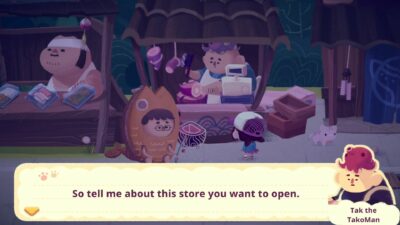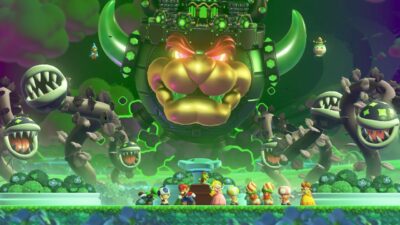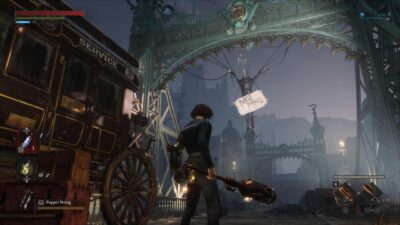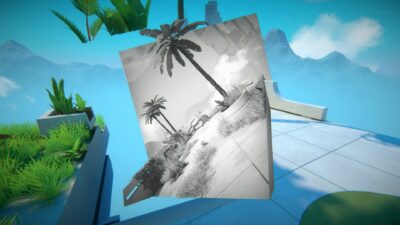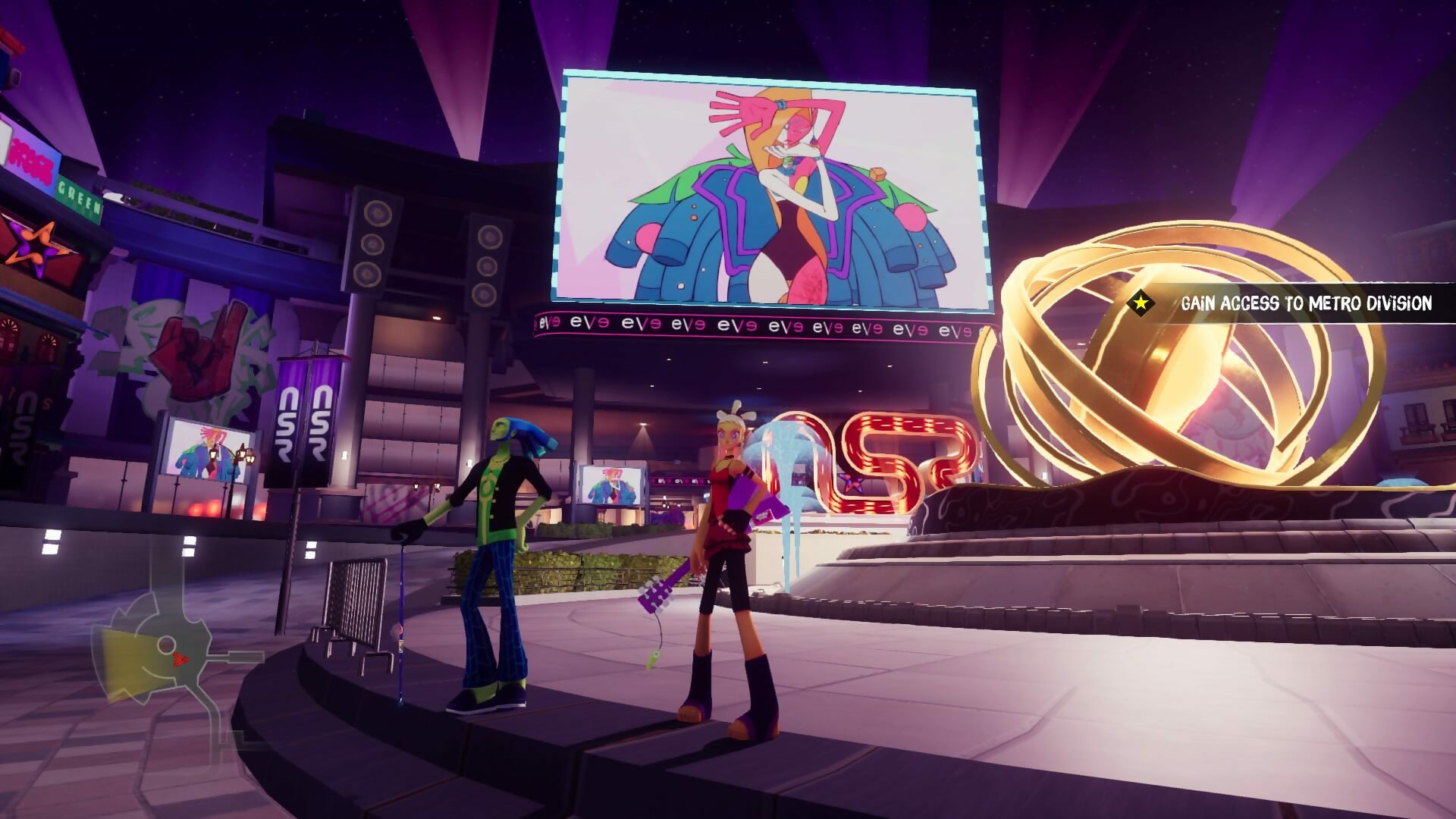
No Straight Roads is like the HD remaster of a Dreamcast or PlayStation 2 game that never existed – it’s a journey through a time warp to the heyday of colourful mid-tier oddities like Katamari Damacy and Jet Set Radio.
But while it shares the vibrant enthusiasm of those millennial classics, so did many less successful ex-periments of the era that have long since faded from memory. When it comes to providing a coherent experience, NSR would likely have more in common with the latter.
There’s certainly a strong vision behind NSR, but it’s heavily fixated on its infectiously cheesy retro vibe. The sassy characters are all bold poses and sculpted haircuts, delivering dated nineties atti-tude and humour that somehow sustains a quaintly offbeat charm.
Brattish protagonist Mayday is irrepressible in her single-minded mission to reintroduce rock music to Vinyl City. Arch-villain Tatiana, who enforces the order of electronica over the land, channels peak Anne Robinson to fine effect. Vinyl City itself pulses with electro-pop, its streets floodlit by animated billboards and dotted with bouncing pedestrians. As Mayday and partner Zuke bound around its districts, even its flat textures and invisible walls seem fittingly old-school.
When it comes to actually doing anything in NSR though, it’s not charming so much as under-developed and messy. Once the game settles, each stage sees you aiming to ‘hijack’ the perfor-mance of one of the city’s favoured EDM artists and win over fans to your band, Bunk Bed Junction (don’t ask). The first task in each stage is simply to cross the city to the next location.

Character designs are consistently lively and detailed, even for the most minor NPCs.
In each themed area, you can collect items that bestow temporary buffs and energy canisters which power up various electrical devices, earning you extra fans. But there’s very little exploration required in these small squares of streets and façades, and no platforms or puzzles to navigate to access items. A few wacky sights and NPCs don’t make up for an absence of meaningful interac-tion.
When you’re done with that, you amble over to your destination, and first have to run the gauntlet of security protecting the act you’re out to challenge. This means moving into the screen, smashing up robots that sporadically jump up and down, or fire missiles in time to the music.
It’s amazing how loosely constructed these sections are, not to mention how little they evolve over the course of the game. Most bizarrely, while your opponents work to a fixed tempo, you never really need to attune yourself to it. Like a particularly dull fighting game, you can single out individual enemies, wait for their attack, then step in and clobber them.

Increasing your fan base provides access to upgrades on skill trees, but most feel largely superfluous.
Any difficulty here is the result of exasperating design. The fixed camera is set too low, hampering your spatial judgement when trying to strike or jump with any accuracy. Floating defence systems blend into busy backgrounds, launching projectiles you won’t see coming. Fudgy controls and your characters’ lolloping gait make it hard to act with any kind of fluidity, scuppering even the simplest hit-and-run manoeuvres.
Things do improve some once you reach the multiphase artist battles that cap each stage. In fact, it’s only in these set pieces that NSR seems truly invested in its experience – as close as it gets to killer tracks on an album stuffed with filler.
Finally, the game reveals a talent for choreographed spectacle and properly enjoys itself by send-ing up a range of music styles and archetypes. In one contest, you’re circling a huge disc spun by an egotistical DJ, in others, you’re pitted against the synchronised dance moves of a literally manufac-tured boy band, or forced to confront a child piano prodigy controlled by a pushy mother. Each of these scenarios throws up its own demands, and a variety of twists along the way.

Boss battles can be replayed at higher difficulty levels with remixes of their music.
Yet the production still isn’t as tight as it should be, and the strongest ideas are often squandered beneath mounting confusion. Again, it’s rarely a case of reacting to the rhythm, just a desperate scramble to get things done between accelerating bombardments of attack waves. And as the camera, control, and visual noise issues combine with poorly defined patterns, it’s hard to fully un-derstand what’s going on. Respawning health crates and instant restarts add a strong suspicion that the game is aware of these problems, but decides to help you stumble through rather than refine the experience.
Perhaps the aim in NSR is to represent the clash between EDM and rock by opposing the predicta-ble rhythm of the computer against the human player’s improvised movements. But that’s little comfort when struggling through something so disjointed.
It’s a game so enamoured with its raucous characters that it lets their haphazard goofiness seep into its underlying machinery. And despite the exuberance and feel-good celebration of all music, it hasn’t much soul, either. It’s crying out for clarity, commitment, and deeper synergy between its soundtrack and action. NSR conjures up an alluring image of gaming’s past, only to remind us how rare the real classics were, and how far we’ve come.
Highlight
It would be criminal if NSR’s soundtrack wasn’t its standout feature, and in the end, it is by a long way. The EDM umbrella plays host to a whole gamut of styles, from thumping club beats to bouncy K-pop. Every boss battle has a distinct toe-tapping flavour, with shifts in intensity as each stage unfolds.
Verdict: 49%
NSR has its image well-honed, but gets stage-fright when it’s time to play.
Genre: Rhythm action
Format: PS4 (tested) / PC / Xbox One / Switch
Developer: Metronomik
Publisher: Sold Out Software
Price: £34.99
Release: Out now


